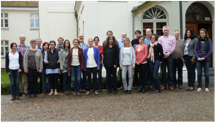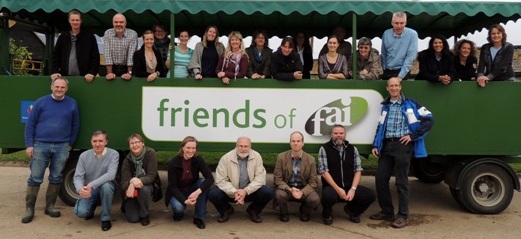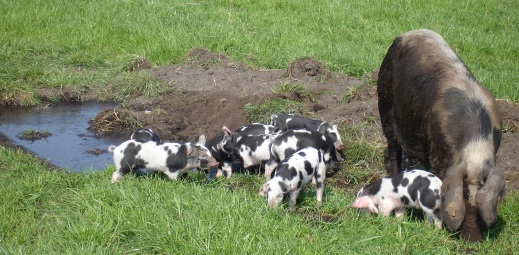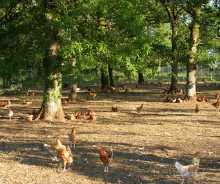Project stakeholders
| The main target groups, both within partner countries and across Europe are organic farmers, their advisors, the organic supply chain (feeds on the one hand and pork and poultry producers on the other), organic certification bodies and policy makers. |
Projectmeeting in Trenthorst, Germany
 [The ICOPP project group had a meeting in Trenthorst 22-23 October 2013. Preliminary results from the seven WP's were presented on the first day. The second day was mainly for coordination among and within each WP. The next project meeting will be in Denmark, 10-11 June 2014, at Aarhus University in Foulum.]
[The ICOPP project group had a meeting in Trenthorst 22-23 October 2013. Preliminary results from the seven WP's were presented on the first day. The second day was mainly for coordination among and within each WP. The next project meeting will be in Denmark, 10-11 June 2014, at Aarhus University in Foulum.]
|
|

Developing sustainable 100% organic feed strategies for pigs and poultry
Introduction
The aim is to produce economically profitable feeding strategies with the ingredients produced organically and sourced within Europe rather than relying on protein imports and feed supplements of non-organic origin. The local 100% organic feeds must provide the required level of nutrients for different phases of production thus supporting high animal health and welfare, while being economically and environmentally sustainable. The project involves 15 partners across 10 countries in central and northern Europe.

Background
This project is looking into the problems faced by farmers in meeting the future requirement to feed organic pigs and poultry on 100% organic feed. Up until now organic pig and poultry (monogastric) production systems have been allowed to use feed ingredients of non-organic origin. There is concern that a move to a 100% organic diet may not supply sufficient sources of certain essential amino acids, and there is very little experience and limited information on the implications of a shift in feeding strategy to 100% organic.
| Benefits of the project
Through cooperation between 15 partners across Europe, an extended knowledge of the characteristics of different local feeds will be brought together. Their wider impact on growth, health and welfare and the environment will be used to produce feeding strategies which comply with the organic principals for high animal welfare and environmental concerns whilst maintaining production economy. The results of desk studies and experimental work will be drawn together to give a comprehensive overall look at what Europe can grow to feed our monogastric animals in a way which is sustainable; both for the environment and the economy.
The results of this project will be of benefit to organic farmers, their advisors, the organic supply chain (feeds on the one hand and pork and poultry producers on the other), organic certification bodies and policy makers.
Expected results
The main result of the activities for the sector is that appropriate feeding strategies are developed that better comply with the principles of organic farming, comply with the requirement of 100% organic feed for monogastrics, and at the same time is profitable and ensures an improvement in environmental impact and animal welfare compared with the current prevailing systems. Specifically, the project will provide:
Improved knowledge of availability and nutritional value of underutilized or new organic feed ingredients per animal category with a focus on local feed resources.
Improved understanding of the possible benefits of roughage inclusion in relation to nutritional and behavioral needs as well as its impact on health and welfare.
Understanding how direct foraging in the outdoor area can contribute to meeting the animal's nutritional needs.
Assessing the economic and environmental consequences of increased reliance on local organically produced feed.
The research and development will result in appropriate feeding strategies established for organic farming with 100% organic feed, which is profitable, has low environmental impact and high animal welfare.
|
Main outcomes at this stage?
Local feed availability
The nine countries involved in ICOPP cover 50 %
of European organic arable land and produce 85
% and 80 % of organic pigs and poultries, respectively.
Self-sufficiency of feed dry matter varies from
5 % to 430 % with an average of 69 %, whereas
self-sufficiency of crude protein is on average 56 %.
Thus, new and protein sources are needed for pigs
and poultry.
Re. Pigs
- Sainfoin seeds are of high nutritional value,
particularly if dehulled (similar to soybean cake),
and can partially substitute commonly used protein
sources also in feeding of weaners, which
otherwise often are most difficult to feed on
local feed resources.
- Nutrient content of grass pea seeds is slightly
higher than that of faba beans, but caution must
be taken due to antinutritional substances. Grass
pea seeds can partially substitute commonly
used protein if subjected to appropriate heat
treatment, also for weaners.
- Mussel meal can replace common protein sources
in feed for growing/finishing pigs with maintained
production results in terms of growth,
feed efficiency and carcass quality.
- Inclusion of roughage (grass-silage) in a mixed
diet with concentrates for growing pigs does
contribute to the protein supply and prevent
ulcer damages, but the overall production results
(daily gain and feed conversion rate) becomes
poorer, and at the same time activity/competition
at the feed trough may increase resulting in
more skin lesions.
- foraging on well-established lucerne can
pose an important contribution to energy and
protein supply in fattening pigs if the pigs are
fed restrictively with a low-protein feed mixture
and if the pigs get regularly access to new land
(strip-grazing).
Re. Poultry
- Protein from organically produced Spirulina algae
can fully replace protein from traditional organic
sources in broiler diets.
- Refining of ingredients of plant origin enriching
the relative content of Methionine seems to be a
useful way to supply relevant protein sources for
poultry, e.g. for sunflower seed expeller.
- Energy dilution of the diet, concomitant with a
proportional reduction in other nutrients, e.g.
dig. Methionine, is an option as well to fulfil the
requirement of 100 % organic diets. This can e.g.
be relevant when including high quality roughage in the feed mixture
for layers.
- Crushed mussel shells (particle size 10-20 mm) supplied in the
litter on every day basis to layers affected neither birds’ feather
cover, nor other welfare parameters or production performance.
Crushed mussel shells cannot fully replace dietary calcium as
calcium source without impairing bone health and egg shell
strength.
- Low-protein diets stimulate the broilers to forage on the range
area and direct foraging can pose an important contribution to
protein supply in broilers of slow-growing genotypes without
detrimental effects on growth performance.
|
 Main activities
Main activities
Organic feed production throughout Europe will be assessed with regard to availability and suitability as feed components for monogastrics by using existing land-use databases and interviewing national organic sector bodies, feed mills, national authorisation bodies, and scientists. The feeding value of novel feed resources will be evaluated by a common methodology. A range of feeding experiments will be carried out with pigs (sows, piglets and finishers) and poultry (layers and broilers), clustered around concentrate feedstuffs, roughage, and foraging. Finally, an integrated impact assessment will identify a number of generic systems based on local 100% organic feed that are 'optimized' according to differences in local feed resource availability and agro-ecological conditions throughout Europe.
|
|
Search Organic Eprints

The open archive includes a vast amount of documents on organic certification
Search the open archive
More search options on www.orgprints.org
| |
ICOPP

13 partners, 10 countries
Coordinator
Head of research unit John E. Hermansen, Dep. of Agroecology and Environment, Faculty of Agricultural Sciences, University of Aarhus, Denmark
Partners
Herman Vermeer, Wageningen UR Livestock Research, The Netherlands
Jo Smith, Organic Research Centre, United Kingdom
Maria Neil, Swedish University of Agricultural Sciences, Sweden
Werner Zollitsch, BOKU-University of Natural Resources and Life Sciences Vienna, Austria
Friedrich Weissmann, Institute of Organic Farming, Germany
Liisa Voutila, Agrifood Research Finland, Finland
Gerhard Bellof, University of Applied Sciences Weihenstephan-Triesdor, Germany
Monique Bestman, Louis Bolk Institute, The Netherlands
Ruth Clements, Food Animal Initiative, United Kingdom
Veronika Maurer, Research Institute of Organic Agriculture (FiBL), Switzerland
Joannie Leroyer, Institut Technique de l´Agriculture Biologique, France
Virgilijus Skulskis, Lithuanian Institute of Agrarian Economics, Lithuania
|
|